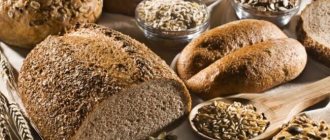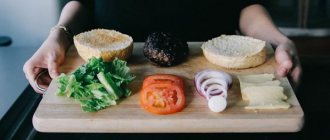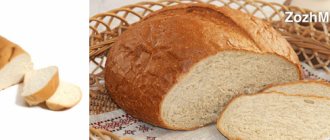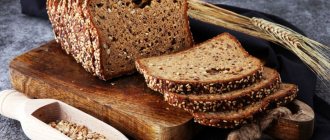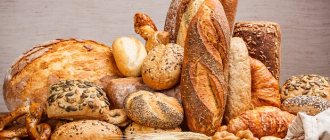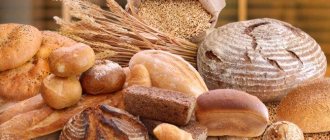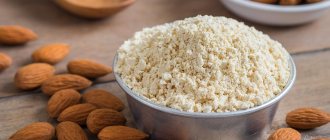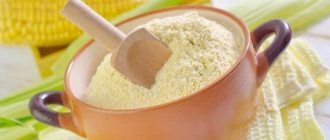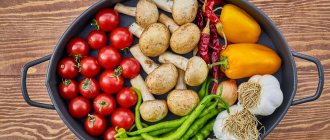18.10.2019 00:00
20616
The fashion for gluten-free products, incredibly popular today in almost all developed countries, has finally reached the post-Soviet space. Why this happens and at what point flour products turned into enemy number one will be discussed in this article.
Author: Ashurbekova Shamsiyat Tofikovna
The fashion for gluten-free products, incredibly popular today in almost all developed countries, has finally reached the post-Soviet space. Carefully, like the first snowdrops, “gluten free” products peek out from under the counters with Borodino bread and about a thousand varieties of white bread.
The “Gluten Free” label can be found not only on baked goods, but also on pasta, cereals, quick breakfasts - in general, wherever flour or flour products are potentially present.
It is difficult for a Russian person who grew up with the saying “bread is the head of everything” to understand the desire of nutritionists to exclude bread from the diet or severely limit the consumption of bread. And if earlier the ban on flour applied mainly to people trying to lose weight, today the refusal of white bread is practiced by almost all adherents of a healthy lifestyle. Why this happens and at what point flour products turned into enemy number one will be discussed in this article.
Myth. Bread contains only empty calories
In fact. Bread has a rich vitamin and mineral composition. There are B vitamins (1, 2, 5, 6, 9), manganese and magnesium, which are necessary for the nervous system to protect against stress. In whole grain bread, for example, 130 mg of magnesium per 100 g is a third of the daily dose. Bread contains molybdenum, silicon and selenium, copper and cobalt, phosphorus and zinc. Bread is a source of dietary fiber, fiber, which is necessary for the health of intestinal microflora, and therefore for immunity.
Bread made from rye flour is the most healthy, as it contains more vitamins, minerals, and dietary fiber. It is technologically impossible to prepare such bread without acidifying the dough with starters. As a result, alcoholic and lactic acid fermentation simultaneously occurs in rye dough with the formation of organic acids necessary for the body, which contribute to the development of “useful” microflora.
Soup, pasta, sandwich. What you can eat with bread and what you shouldn’t Read more
Crackers: benefits and harms
Crackers are dried slices of bread alone or with the addition of raisins, sesame seeds and poppy seeds. They are a product that is very rich in fiber, phosphorus, iron, potassium and magnesium. They also contain a lot of easily digestible carbohydrates.
The main positive difference between crackers and fresh baked goods is that they are not capable of causing flatulence, which is very important for older people. Rusks help the body regain strength in the postoperative period. They will be a good analogue of bread for those who want to lose weight.
But along with their positive properties, crackers can also cause harm. Abuse of the product can cause serious problems and negatively affect intestinal function. There are crackers of various types, shapes and tastes on sale. The taste of crackers is given by flavorings or stabilizers, which negatively affect the condition of the human body.
Myth. Bread provokes type 2 diabetes, increases weight
In fact. They gain weight not from carbohydrates, but from their quantity. The need for carbohydrates for any person is 50–60% of daily calories. But carbohydrates are different from carbohydrates. Those who want to lose weight should choose complex, “slow” carbohydrates that do not lead to a sharp jump in blood sugar and give a long-lasting feeling of fullness. And added sugar should be limited to 10% of daily calories. Black and gray bread is useful for dieting: it is rich in dietary fiber and gives a long-lasting feeling of fullness.
Diabetes is not caused by bread, but by excess food, which leads to the formation of fatty tissue in the body. Bread, primarily rye, in acceptable quantities protects against diabetes: it is rich in dietary fiber, valuable for people with impaired carbohydrate and lipid metabolism.
Beneficial features
Flour baked goods are very popular among adults and children due to their indispensability. It is an integral part of both a family dinner and a festive banquet. Many people don’t even think about the benefits and harms of bread, eating it every day. This is a convenient way to have a snack, because the same sandwich can be prepared very easily and quickly.
Naturally, bread has benefits for the body. First of all, it is the elimination of hunger. It is very difficult to work fully on an empty stomach.
Why flour is so beneficial for health and whether it is worth consuming it daily is difficult to answer. Basically, it’s just a habit: the habit of snacking on sandwiches, buying cookies, bagels or tea buns. But don’t forget about the beneficial properties of baked goods:
- assistance in regulating metabolism;
- influence on improving memory;
- the presence of many vitamins, fats and minerals;
- protein supply;
- satisfying the feeling of hunger.
So, there is a benefit. But it’s better to be careful when choosing baked goods, and you shouldn’t overuse them. After all, it is impossible to say for sure whether bread is healthy for everyone.
There will also be those who will have to give up this delicacy almost for the rest of their lives or limit themselves to a small dose of flour. This primarily applies to people who are prone to obesity. And for those who care about the slimness of their figure, it is better to stop at bread or dietary bread, which will be the healthiest for them.
Myth. Bread contains gluten - poison for the intestines, liver and gallbladder
In fact. Gluten, or gluten, is a group of proteins found in wheat, rye, barley, and other grains. People with celiac disease (celiac disease) should exclude this substance from their diet. Everyone else need not worry. Gluten, like other plant proteins, is a source of essential amino acids.
100 types of bread. How does matzo differ from tortilla and pita bread? Read more
Diseases from flour
Eating white yeast breads leads to obesity . Every seventh person experiences intolerance to a component of flour – gluten. The disease usually manifests itself:
- intestinal symptoms (bloating, diarrhea or constipation). The glycoprotein gluten, like a dense adhesive mass, covers and binds the intestinal villi. Next, their inflammation and irreversible death occur;
- skin symptoms (itching, rash, eczema, even ulcers);
- manifestations of the nervous system (tinnitus, headaches, depression, memory loss);
- state of inattention (complete lack of libido).
Eventually osteoporosis, diabetes and cancer develop.
Myth. White bread is bad for you
In fact. Bread made from wheat flour has less fiber and vitamins than black and gray bread made from whole grains, but in some situations white bread is preferable. Only a product made from seeded flour or flour of the first and highest grades is recommended for people whose digestive tract requires easily digestible food (for example, after surgery on the digestive organs). There are diseases of the gastrointestinal tract - colitis, gastritis with high acidity, peptic ulcer of the stomach and esophagus - when aggravated, eating black bread can cause pain, flatulence and other troubles. In such cases, white bread is recommended. Dried is better, because freshly baked white bread can cause similar symptoms in people with gastrointestinal problems (it will not harm everyone else if eaten in moderation). White bread is indicated for people who are underweight.
“So I went for some bread”
Even taking into account that the manufactured product was produced in compliance with technical conditions, you can easily get a simple foodborne illness from bread. It is convenient and practical to choose your favorite pastries in the self-service area. But no one guarantees that before you, someone infectious could not have sneezed, coughed, or even touched this sweet bun. As a result, 18% (every fifth bakery product) ends up with toxins.
Pesticides are used to control pathogens. But environmental audits in agrochemical laboratories and food analysis cannot guarantee 100% safety. Of the 600 existing pesticides, approximately 154 have developed schemes for determining the residual quantities of these poisons in food products.
Genetically modified plants are used everywhere: wheat, rye, corn, peas, soybeans. And all this goes to the production of flour for “healthy” baking. Conducted studies on rats have already proven the occurrence of mutations and infertility within a generation.
If you look at the human gene pool:
- the appearance of congenital diseases associated with gene mutations;
- shortening of the male Y chromosome;
- cancer has increased exponentially over the past 100 years.
During the process of evolution, plants began to produce lectins - plant poisons that help plants reproduce and survive. Wheat, barley, rye and oats contain these toxic chemicals. A seed eaten by a bird causes an inflammatory reaction in the intestines. And the preserved seed embryo receives additional nutrients from the droppings. In the human body everything is more complicated. Allergist David Fried described autoimmune processes when antibodies arise to one's own tissues. The harm of flour manifests itself in the form of inflammation of the joints and glomeruli of the kidneys, damage to the valve apparatus of the heart, and disruption of the functioning of the entire immune system.
The main elements of baked goods that kill health: flour; yeast; leavening agents; preservatives; flavorings.
Flour was not so “white and fluffy” 100 years ago. It was coarsely ground, with impurities and a shelf life of about 5-6 months. Modern processing methods make it possible to obtain white flour, completely devoid of fiber and germ, almost entirely consisting of starch and residual sugars. There is no need to look for vitamins in such flour. Even in wholemeal flour they are preserved in the first 2 weeks. Manufacturers have noticed that the addition of dry gluten leads to an increase in the shelf life of the bakery product and an improvement in presentation.
It’s nice when the resulting sweet white bun doesn’t wrinkle. However, such a product clearly does not bring the expected satiety. It is beneficial to add gluten to low-grade flour to get a LOT IN NEW business.
Yeast. To accelerate fermentation in bakery production, Saccharomycetes cerevesie and Diamanticus are used for wheat flour. Saccharomyces minor – for rye. Approximately 0.1 - 8% of the flour weight is yeast. Research conducted by the Frenchman Etienne Wolf on stomach cancer tissues has proven that tumor growth is accelerated by 3 times in a medium containing this yeast. It turned out that they produce epidermal growth factor. It was noted that antibiotics do not reduce yeast activity. Ascomycetes form ascospores, they are not harmed by saliva, and these bastards live quietly after baking. Heat treatment at 180-200 degrees. doesn't kill them!!! They will live off the human body.
Myth. Rye flour has less calories
In fact. Flour has the same calorie content: 340 kcal per 100 g. But bread is not only flour, so the calorie content of the finished product is higher. Rye and rye-wheat bread has 200–230 kcal, a white loaf has 250–270, and toast bread has 300 kcal. Brown bread can be higher in calories than white bread if seeds, nuts, and raisins are added to it. The calorie content of any bread is really high, so the daily norm is 150 g per day.
Three crusts. How to reanimate and what to use dried bread for More details
Correct choice and use
In order not to harm the body, you need to follow a few simple rules:
- The selected product must not have any visible damage;
- The product must have a natural color;
- The loaf should not have black soot, which contains carcinogens;
- It is important to pay attention to the expiration date, composition and manufacturer (must be indicated on the packaging);
- You should not eat bread that is moldy, has a bad smell, or is poorly baked;
- You should not make large stocks of flour products;
- The crust is much healthier than the crumb;
- When consuming fatty foods, broths or seafood, it is better to give preference to a piece of rye;
- It is better to eat potatoes and meat dishes without bread;
- Yesterday's loaf is much healthier than freshly baked loaf;
- It is better to consume bread products in the first half of the day in small portions.
Your own baker
Tired of store-bought loaves? Try baking bread at home. It's not difficult, and you can try non-trivial recipes.
Gluten-free buckwheat bread
Ingredients : buckwheat flour – 350 g, cold water – 750 g, egg – 2 pcs., dry yeast – 20 g, sesame – 10 g, fried onion – 50 g, vegetable oil – 30 g, sugar – 20 g, flax seeds – 10 g, apple cider vinegar – 5 g.
How to cook : mix all ingredients and knead the dough. It is important to use cold water so that you have time to knead the dough before fermentation begins (if you use warm water, the dough will turn out loose and will be inconvenient to work with). Let the dough rise in a warm place for 1 hour. Place the dough in a baking dish or simply on a baking sheet. Bake in the oven for 20 minutes at 200°C. After baking, let the bread “rest” - cool. Please note: gluten-free bread will be denser than wheat bread.
Palm bread with nettles
Ingredients : wheat flour – 250 g, palm flour (sago) – 250 g, water – 150 ml, salt – 6 g, sugar – 10 g, yeast – 7 g, dried nettle – 50 g.
How to cook : prepare a dough using ⅓ part wheat flour and ⅓ part palm flour, water, sugar, yeast and salt. Let rise for 2 hours. Add the remaining flour, knead and let rise for another half hour. Knead 3 times and let the dough rise. Divide the dough into equal balls and bake at 180˚C for 15 minutes. Grind the nettles and sprinkle on the finished bread.
The effect of baker's yeast on the body
In 1940, centuries-old baking traditions underwent significant changes. Bakers have always been dissatisfied with the long process of bread production, during which the dough takes about a day to rise. Therefore, thermophilic yeast has replaced hop yeast, on which the dough rises in an hour. Unlike hop yeasts, thermophilic yeasts are considered opportunistic microorganisms that can cause diseases under certain conditions.
There is an opinion that baker's yeast negatively affects the formation of beneficial flora in the intestines, provokes fermentation, thereby causing rotting processes and other pathogens.
As is known, at a temperature of 60℃, the yeast microflora practically dies, and when the temperature reaches 70℃, even yeast spores die. The bread is baked at 200℃, while the temperature of the inner layer of crumb reaches 98℃. Yeast cells and spores can only be present in bread when the bread is not baked. Therefore, it is forbidden to eat unbaked, raw bread .
Good to know! The first sour dough appeared in ancient Egypt.
Cooking technology
Preparation of raw materials:
- Aeration saturation and sifting of flour.
- Water filtration.
- Preparation of salt and sugar solution.
- Preparation of yeast suspension.
Fermentation:
- Mixing the main ingredients in the required proportions.
- Kneading the dough.
- Fermentation of dough with yeast.
Molding:
- Portion division of ripened dough.
- Shaping.
Dissolving:
- Fermentation of finished products at the required temperature and humidity.
- Notching.
And only after this is baking done.
The main difference between yeast bread and sourdough bread is that in the first, at the stage of mixing the ingredients, the dough is kneaded using ready-made baker's yeast, and not sourdough, as in the second. Whey, amaranth, hop cones, citric acid, fruit extracts, wort, sugar, honey can be used as a starter. The fermentation process with it is more labor-intensive and time-consuming. It takes 2-3 days, while fermentation of yeast bread occurs within a maximum of 14 hours. This also explains the higher price for so-called yeast-free products.
One of the advantages of sourdough is its naturalness, however, numerous studies have shown that in terms of the amount of various impurities (including synthetic ones), both types of bread are practically the same.
Did you know that... ordinary yeast, after special processing, acquires the taste of real Parmesan and can even replace it in some vegetarian dishes?


